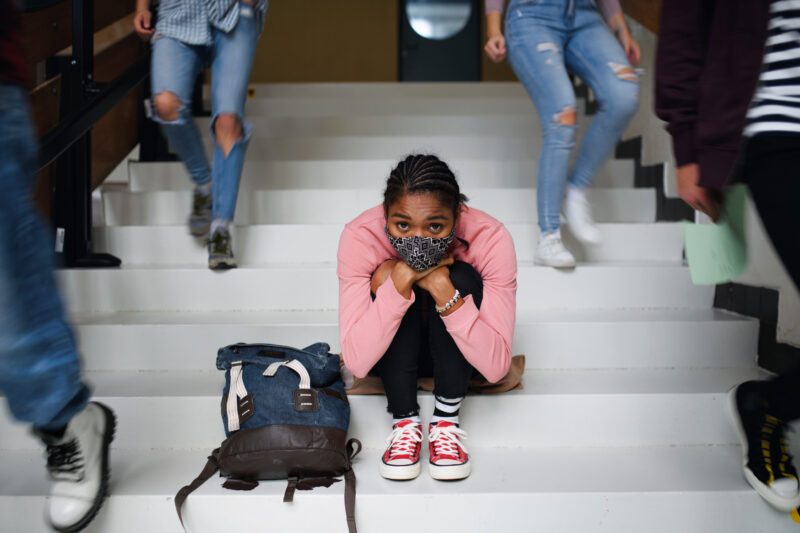5 Steps for Developing Protective Factors against Teen Suicide
Tylor blamed herself for everything wrong in her life and saw no hope for her future. She'd never been in trouble before, but she'd just gotten caught bringing marijuana to school and was suspended. As a result, she felt like everyone was disappointed in her, and she felt like she had irrevocably ruined all her dreams and plans for the future. She sat in suspension alone in her pain, seeing no way to recover. She blamed herself for everything wrong in her life. When she left school that day, she went into her basement and took her life. Protective factors could have made a difference in her story, and they can make a difference in your teens' too.
Tylor’s story is not unique. Every day teenagers across the nation die by suicide, teens who should have lived and prospered, teens who deserved to be happy. Their deaths, these tragedies, impact families and communities forever. And whether anyone in your school has taken their life or not, you can be sure that suicide has had some impact on your teens one way or another.
Who is at risk for death by suicide?
Not everyone is at equal risk for death by suicide. Risk factors (as defined by the suicide prevention resource center) are characteristics that make it more likely that individuals will consider, attempt, or die by suicide. As one would expect, the more risk factors individuals have, the higher their statistical risk of death by suicide.
Researchers have identified many risk factors when it comes to suicide. The biggest include substance abuse, mental disorders, access to lethal means, suicide in a person’s family or knowing someone who has died by suicide, and chronic disease or disability. But these are just a few of the risk factors we see.
Many at-risk people are also
- Members of the LGBTQ community
- Culturally unique
- People who have been through trauma (a painful experience)
- Victims of a crime
- People who suffer from mental illness
- Those going through a big life change
- People dealing with a loss
- People who make impulsive decisions
For anyone who works with teens, you can probably picture what these risk factors look like in a young person’s life. In fact, odds are that every teen in your school has at least one risk factor. Many will have a laundry list of them. It’s enough to put any teacher or administrator in a panic.
Risk factors are not warning signs.
But just because a student has multiple risk factors does not mean a potential suicide looms in their future. SPRC.org makes an important differentiation between risk factors and warning signs of suicide. “Warning signs indicate an immediate risk of suicide, whereas risk factors indicate someone is at heightened risk for suicide but indicate little or nothing about immediate risk.”
It's important to be aware of risk factors, but they are not a reason to jump into intervention. However, risk factors also should not be ignored. With teen suicide reaching epidemic proportions in today’s society, parents, teachers, and other adults must do all that we can to help our teens see a happy, successful future for themselves.
Decreasing and even eliminating all risk factors for all our teens would be ideal, but it’s not realistic for many reasons. As any educator knows, it's difficult for school leadership to know the ins and outs of every student’s past. Even when teachers have close relationships with their students, risk factors are often information teens choose to keep secret. Sometimes even from themselves.
And so elimination of risk factors seems impossible when we can’t even know that they exist in the first place.
Enter protective factors.
Protective factors matter.
The good news is that risk factors are not all that matters. Equally important are protective factors: characteristics that make it less likely that individuals will consider, attempt, or die by suicide.
Eliminating risk factors is challenging, but building and strengthening protective factors may be an easier and equally beneficial route for schools to take. And a lot of protective factors can be built through social and emotional learning, something most schools are emphasizing anyway.
Both risk factors and protective factors have items that cannot be changed (such as family history of suicide) and those that can be changed (such as access to mental health care).
To successfully build protective factors in our students’ lives, we need to place our efforts on those things that can change.
What protective factors can schools focus on?
To successfully build protective factors in your teens, you have to take some time to think through the process. Many protective factors must be intentionally built and developed.
First, get a feel for the protective factors that are most lacking in your school population. Each community and even each school will have its own unique needs. If you aren’t already aware of what your school’s needs are, you can start by looking at three different areas where we see protective factors in individuals. Remember, schools must look at those protective factors they can influence, so the following list is not complete but is a good place for school personnel to start.
Personal Protective Factors (an individual’s circle of support)
- Do the students at your school have supportive and caring family and friends?
- Are your students optimistic?
Internal Protective Factors (an individual’s inner strength and skills)
- Do your students possess problem-solving skills?
- How are their decision-making skills?
- Are students exhibiting anger management skills?
- Do your students possess conflict resolution skills?
- Can you see impulse control in their decisions?
- In general, do your students have strong self-esteem?
- Do you see a sense of personal control among your students?
- Do your students exhibit coping skills?
External Protective Factors (an individual’s world around them)
- Do your students exhibit connectedness to community, school, family, and friends?
- Is there immediate and ongoing support and care for both medical and mental health for your students?
- Do your students have opportunities to contribute to school projects or activities?
You can find a more complete list of protective factors at Western Michigan University’s Suicide Prevention Plan.
How to increase individual protective factors
1. Decide
The first step in increasing individual protective factors is to identify the protective factor you want to increase. And be specific in the ones you choose to address. For example, don’t just say social-emotional skills. Which specific skills do you want to develop in your school population?
Many of the internal protective factors listed above are directly linked to social-emotional learning. Programs such as BASE Education offer courses in each of these skills. If you have such a program in place or are considering an SEL program, you might choose to work on increasing one of these specific skills in your students.
2. Plan
Once you have chosen the protective factor you want to increase, it’s time to decide what actions you will take to bring about that change. Will you enroll your students in a self-esteem course? Should you bring a guest speaker who can talk about anger management skills? Will you increase awareness of student resources through an awareness campaign?
3. Follow Through
Once you have decided what steps you need to take, put your plan into action. If it seems overwhelming at first, break your plan into small, incremental steps. Then schedule each step for implementation.
4. Evaluate
After your plan is implemented, you aren’t finished. Regular reflection on and evaluation of your strategy will help you know what is going well and what needs to be improved. So look at what is working, what isn’t working, and where you can make adjustments.
5. Adjust
Almost any plan will have areas it can improve, even the best ones. As you evaluate, adjust your plan wherever necessary to make sure students get the most benefit out of what you are offering. Continue evaluating and adjusting your plan on a regular basis.
A hopeful future
On average over 3,470 young people in grades 9–12 attempt suicide each day in our nation. If you add in the students from younger grades who attempt suicide, this number is even higher. This is not something that schools, adults, and parents can ignore.
But the future is not without hope either. Schools need not turn a blind eye to the epidemic of teen suicide, even if they are limited in the risk factors they can decrease. By increasing protective factors in our school bodies, our students will be stronger and more capable of handling life’s difficulties. As a result, they will be less likely to die by suicide leaving a trail of pain in their wake. Adults can and do impact the lives of the teens around them, and increasing protective factors is one way to make that influence count.



